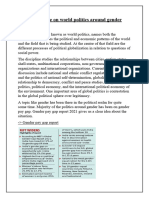Week 4
Week 4
Uploaded by
Hemalatha DevarajooCopyright:
Available Formats
Week 4
Week 4
Uploaded by
Hemalatha DevarajooOriginal Description:
Copyright
Available Formats
Share this document
Did you find this document useful?
Is this content inappropriate?
Copyright:
Available Formats
Week 4
Week 4
Uploaded by
Hemalatha DevarajooCopyright:
Available Formats
EDU TUTORIAL WEEK 4
Good evening to the members of the floor. Today, we are going to discuss about a very hot issue, Gender Inequality in Educational Opportunities. To share their views and opinions, we have two wonderful guests here. On my right, we have Miss Hemalatha Devarajoo, the Deputy Director General of Ministry of Higher Education. On my left, we have Miss Sam Yujia, the counsellor of SMK Methodist ACS Ipoh, Perak. 1.) Deanne: Without further ado, can you share with us the statistics of the number of males and females enrolling into the higher institutes worldwide and in Malaysia? Hema: A recent national intake shows that women dominate more than 70 per cent worldwide and 60 per cent of the overall intake in Malaysia. Over the last three decades, there has been an increased participation of women in higher education. However, one common observation made by UNESCO is that women tend to concentrate in traditionally female subject areas such as arts and social sciences. Those days, it was incongruous. The male species dominated higher education. The percentage of women with higher education in the total population vis-a-vis men has increased gradually over time. In 1980, women comprised 31.7 per cent of people with higher education. The figure increased to 40.6 per cent in 1991 and further increased to 47.5 per cent in 2000. Women enrolment at all levels of higher education increased significantly between 1985 and 2008. Traditionally, significant gender-related issues in education pertain to gendersegregation and stereotyping as highlighted by Aminah (1998). This is because women have been associated with traditional fields such as education. However, nowadays women have been given chances to select any program without limitation. As a result, more and more women are taking programs which were previously associated with the masculine type. Thus, the enrolment of women at all levels of education is equitable to that of men. 2.) Deanne: What were the factors contributing to this issue then? Hema: The factors are; Stereotypes Mommys track (delay in career due to woman bringing up family)
EDU TUTORIAL WEEK 4
Glass ceiling (A glass ceiling is a political term used to describe "the unseen, yet unbreakable barrier that keeps minorities and women from rising to the upper rungs of the corporate ladder)
No (or Low) Direct Benefit from Investing in Girls Education The social returns to educating boys and girls are the same, but that parents expect more direct benefit from investing in sons if, for example, sons typically provide for parents in their old age, while daughters tend to leave and become part of a different household economic unit (after their marriage). In this case, the wedge between private and social returns generates a market failure, and the private decision to invest in girls schooling is likely to be inefficient.
Early marriage and pregnancy
3.) Deanne: Now for the current setting, what are the factors contributing to this gender inequality in educational opportunities? Sam: The factors are; Hidden curriculum in school Girls= household/cooking
Boy= carpentary/electronics
Boys skip class to go to cyber cafe according to my observation Men feel like they have to be more responsible to earn money; work after SPM instead of higher education
4.) Deanne: There should be quite a lot of implications and consequences that will be faced by the individual and their families because of this issue. May I have your view on this? Sam: The implications are; Less qualification, lower position Women do not have to rely on men Avoid violation Women= breadwinner Double salary for the family
EDU TUTORIAL WEEK 4
5.) Deanne: Can you share your opinion on the implications that will be faced by the society and also the country? Hema: Lower fertility and mortality rates according to statistics 6.) Deanne: Are there any ways that you would like to suggest to actually solve this gender inequality issue in terms of educational opportunities? Sam: I would like to propose three suggestions; Parents need to play their role (PIBG) Pursue your dream (men can be nurses and women can be engineers) Find their interest (technical school)
7.) Deanne: Do you have any other suggestions to overcome this issue? Hema: Having campaigns, educational trips and camps
Questions from the Floor 1.) Nur Rakin: Are the statistics similar for public and private higher institutions? Hema: Statistics show that in 2008, women represented 57.2 per cent of all graduates from higher learning education institutions. The share of 62.7 per cent of graduates in the public higher learning institutions are women, while in private institutions their share is 56.5 per cent. 2.) Karen Ting Jia Sze: What if your students approach you and say that he/she does not want to study further? What will be your action and advice? Sam: Do not force them. I will find about their interest (technical school). 3.) Nadiah Shukri: If a male student approaches you and says that he wants to pursue his dreams to be a fashion designer which is stereotyped as females choice of job, what will you do? Will you encourage him to follow his dream or advice him not to do so and persuade him to change his ambition? Sam: I will advise him to follow his ambition. He is responsible for his own ambition. I do not want him to blame me if he have any difficulties but I will surely discuss with him about the advantages and disadvantages of other careers and also his chosen career.
You might also like
- Sale Purchase Agreement TemplateDocument3 pagesSale Purchase Agreement TemplateMay&Ben67% (3)
- Bhakti Vaibhava Course-1Document3 pagesBhakti Vaibhava Course-1Anant KumarNo ratings yet
- The Effects of Poverty On EducationDocument16 pagesThe Effects of Poverty On EducationAlif Anam100% (2)
- Local 20 Internal Report ResponseDocument1 pageLocal 20 Internal Report ResponseLocal12WKRCNo ratings yet
- Monthly Payment: Amortization ScheduleDocument20 pagesMonthly Payment: Amortization ScheduleadnanNo ratings yet
- Attendee List 10-27-14Document8 pagesAttendee List 10-27-14henryhayesNo ratings yet
- Research ReportDocument4 pagesResearch Reportapi-441461773No ratings yet
- 19 Everybody Wins When Girls Can Stay in SchoolDocument17 pages19 Everybody Wins When Girls Can Stay in Schoolananiko2010No ratings yet
- Women and Education in IranDocument5 pagesWomen and Education in IransalimehaliNo ratings yet
- Critical ThinkingDocument8 pagesCritical ThinkingXile LohNo ratings yet
- Girl Education: A Lifeline To Rural Transformation in India: April 2015Document5 pagesGirl Education: A Lifeline To Rural Transformation in India: April 2015AGl NarhatNo ratings yet
- Fatimav 2Document5 pagesFatimav 2nassimfatima05No ratings yet
- The Top 10 Gender Bias Updates Cultural Support of SexismDocument5 pagesThe Top 10 Gender Bias Updates Cultural Support of SexismNelsonNelsonNo ratings yet
- The Effect of Gender Iniquality To The Academic Performance of SHS Students of EltnhsDocument9 pagesThe Effect of Gender Iniquality To The Academic Performance of SHS Students of EltnhsElisha Melvy Paas PalaciNo ratings yet
- Gender Inequality, Concerned Problems & Education: Dr. Pranita Singh (A.N.D.T.T.C. SITAPUR)Document4 pagesGender Inequality, Concerned Problems & Education: Dr. Pranita Singh (A.N.D.T.T.C. SITAPUR)Priyanka SinghNo ratings yet
- Women's in SocietyDocument15 pagesWomen's in Societylemondaff1No ratings yet
- Psy 512 CH 25Document2 pagesPsy 512 CH 25Maya GeeNo ratings yet
- Girl Education: A Lifeline To Rural Transformation in India: April 2015Document5 pagesGirl Education: A Lifeline To Rural Transformation in India: April 2015sandhya anusuriNo ratings yet
- Gender and Education GenSocDocument12 pagesGender and Education GenSoccarolinesweet250No ratings yet
- Final PapppperrrDocument16 pagesFinal Papppperrrapi-391992162No ratings yet
- EDUCATIONAL PROVISION AND GENDER INEQUALITY IN NIGERIA (Repaired)Document61 pagesEDUCATIONAL PROVISION AND GENDER INEQUALITY IN NIGERIA (Repaired)emmanueldbarnabasNo ratings yet
- Educational Provision and Gender Inequality in Nigeria (05-03-2022)Document85 pagesEducational Provision and Gender Inequality in Nigeria (05-03-2022)emmanueldbarnabasNo ratings yet
- Lack of Education Research Paper 1Document9 pagesLack of Education Research Paper 1api-547809341No ratings yet
- Gss Combined UPDATEDDocument20 pagesGss Combined UPDATEDSarita SharmaNo ratings yet
- Full and Final Thesis Zubaida FareedDocument69 pagesFull and Final Thesis Zubaida FareedMuhammad Farhan100% (4)
- Gender Issues in EducationDocument7 pagesGender Issues in EducationCarina Gozum Carcellar Jabasa100% (1)
- Gender Inequality in Educational Systems: Life OrientationDocument6 pagesGender Inequality in Educational Systems: Life OrientationChevi litsNo ratings yet
- Ethical Awareness On Women Education and EmpowermentDocument27 pagesEthical Awareness On Women Education and Empowermentbhanumv123No ratings yet
- Nder, Education and Skills THE PERSISTENCE OF GENDER GAPSDocument20 pagesNder, Education and Skills THE PERSISTENCE OF GENDER GAPSdaudos2017No ratings yet
- Noakhali Science & Technology University: Submitted By: Submitted ToDocument5 pagesNoakhali Science & Technology University: Submitted By: Submitted ToTridib GhoshNo ratings yet
- Flhs Women EmpowermentDocument18 pagesFlhs Women EmpowermentGIL ALTAMARINONo ratings yet
- Essay English 1Document3 pagesEssay English 1chandrikaNo ratings yet
- Justification Paragraph-4Document4 pagesJustification Paragraph-4api-534756426No ratings yet
- UCSP Editorial EssayDocument4 pagesUCSP Editorial EssayMIHKE PATRICIA RIOSNo ratings yet
- Influence of Gender On The Education of The Girl ChildDocument11 pagesInfluence of Gender On The Education of The Girl ChildgrossarchiveNo ratings yet
- Assignment Update 3Document8 pagesAssignment Update 3Custom CafeNo ratings yet
- YSEALI Summit Bali - Jan 24 - Case StudiesDocument8 pagesYSEALI Summit Bali - Jan 24 - Case Studies8q7sqwqj6hNo ratings yet
- Chapter OneDocument5 pagesChapter OneThomas EmmanuelNo ratings yet
- The Cultural Underachievement of FemalesDocument10 pagesThe Cultural Underachievement of Femalescarol navaretteNo ratings yet
- Gender EqualityDocument3 pagesGender EqualityFadra AnsahNo ratings yet
- Sociology Final Writing AssignmentDocument5 pagesSociology Final Writing Assignmentapi-494902678No ratings yet
- Gender SensitivityDocument32 pagesGender Sensitivitygiovannielizade00No ratings yet
- MF Genderdoc BestDocument19 pagesMF Genderdoc BestNor 'adilah AnuarNo ratings yet
- Problems of Rural Girl Students in Higher Educational InstitutionDocument7 pagesProblems of Rural Girl Students in Higher Educational InstitutionAnonymous CwJeBCAXpNo ratings yet
- Female Education in Developing Countries: January 2017Document8 pagesFemale Education in Developing Countries: January 2017Qasim AliNo ratings yet
- Education and Gender EqualityDocument11 pagesEducation and Gender EqualityMichaela Kristelle SanchezNo ratings yet
- A Discourse On World Politics Around GenderDocument7 pagesA Discourse On World Politics Around GenderAyush ThakurNo ratings yet
- Women in Business - From Classroom To BoardroomDocument16 pagesWomen in Business - From Classroom To BoardroomNina RungNo ratings yet
- UCSP ReportDocument16 pagesUCSP ReportAira ReyesNo ratings yet
- Theme 1Document9 pagesTheme 1Trendy TrendsNo ratings yet
- 30-04-2021-1619780767-8-Ijans-8. Ijans - Role of Tutorial Class in Improving Females' Academic Performance in Case of Bule Hora University First Year Agricultural Economics and Midwifery DepaDocument12 pages30-04-2021-1619780767-8-Ijans-8. Ijans - Role of Tutorial Class in Improving Females' Academic Performance in Case of Bule Hora University First Year Agricultural Economics and Midwifery Depaiaset123No ratings yet
- Group 6 Research and Interview - Gender Equality On Education and CareerDocument8 pagesGroup 6 Research and Interview - Gender Equality On Education and Careerapi-496974186No ratings yet
- Female Education in Developing Countries: January 2017Document8 pagesFemale Education in Developing Countries: January 2017Kayabwe GuyNo ratings yet
- Research Paper - Natalie SneadDocument13 pagesResearch Paper - Natalie Sneadapi-508539690No ratings yet
- Éducation GirlsDocument18 pagesÉducation Girlslateef ben yamineNo ratings yet
- Social Relevance Project Report ON "A Study of Educational Problems of Women in India"Document28 pagesSocial Relevance Project Report ON "A Study of Educational Problems of Women in India"sarita chaurasiaNo ratings yet
- Thesis On High School DropoutsDocument7 pagesThesis On High School Dropoutsheatherlovegrandrapids100% (2)
- Assessment of The ChallengesDocument33 pagesAssessment of The Challengessulemansafiya02No ratings yet
- AF-05-BE D NewDocument10 pagesAF-05-BE D NewLUCKY ABINo ratings yet
- Research On The Factors of Gender Stereotype of Senior High School StudentsDocument8 pagesResearch On The Factors of Gender Stereotype of Senior High School StudentsJeneve Gastalla AlbaoNo ratings yet
- Gender Inequality Should Be Eliminated in The CommunityDocument15 pagesGender Inequality Should Be Eliminated in The CommunityBatrisya SyahNo ratings yet
- Take Away JournalDocument7 pagesTake Away Journalapi-339863258No ratings yet
- The Political Injustice Affecting Our Schools, Teachers and Students: Affecting Our Schools, Teachers and StudentsFrom EverandThe Political Injustice Affecting Our Schools, Teachers and Students: Affecting Our Schools, Teachers and StudentsNo ratings yet
- T-Shirt A T-Shirt This Is A T-Shirt. T-Shirt A T-Shirt This Is A T-ShirtDocument13 pagesT-Shirt A T-Shirt This Is A T-Shirt. T-Shirt A T-Shirt This Is A T-ShirtHemalatha DevarajooNo ratings yet
- Fill in The Blanks With The Correct AnswerDocument1 pageFill in The Blanks With The Correct AnswerHemalatha DevarajooNo ratings yet
- Week 11: Success CriteriaDocument7 pagesWeek 11: Success CriteriaHemalatha DevarajooNo ratings yet
- Week 10: Success CriteriaDocument7 pagesWeek 10: Success CriteriaHemalatha DevarajooNo ratings yet
- Fill in The Blanks With The Correct WordsDocument1 pageFill in The Blanks With The Correct WordsHemalatha DevarajooNo ratings yet
- Read The Text and Answer The QuestionsDocument2 pagesRead The Text and Answer The QuestionsHemalatha DevarajooNo ratings yet
- Elaborate Personality Traits of A Charismatic LeaderDocument18 pagesElaborate Personality Traits of A Charismatic LeaderHemalatha DevarajooNo ratings yet
- Fill in The Blanks With The PrepositionsDocument1 pageFill in The Blanks With The PrepositionsHemalatha DevarajooNo ratings yet
- C-Caring L - Love A - Ardent S - Systematic S - Speaker R - Room O - Open Minded O - Overall M - MeticulousDocument1 pageC-Caring L - Love A - Ardent S - Systematic S - Speaker R - Room O - Open Minded O - Overall M - MeticulousHemalatha DevarajooNo ratings yet
- Developing The Personal Classroom Management System An Emerging Plan For Classroom Management: A QuestionaireDocument2 pagesDeveloping The Personal Classroom Management System An Emerging Plan For Classroom Management: A QuestionaireHemalatha DevarajooNo ratings yet
- Teddy's Adventure: Adapted MaterialDocument1 pageTeddy's Adventure: Adapted MaterialHemalatha DevarajooNo ratings yet
- Level of Difficulty (Year 4)Document2 pagesLevel of Difficulty (Year 4)Hemalatha DevarajooNo ratings yet
- ISL Week 4Document1 pageISL Week 4Hemalatha DevarajooNo ratings yet
- Lam-Pt05-01b Rancangan P P Mingguan TSL 3104Document45 pagesLam-Pt05-01b Rancangan P P Mingguan TSL 3104Hemalatha DevarajooNo ratings yet
- Important Clasroom Management TechniquesDocument1 pageImportant Clasroom Management TechniquesHemalatha DevarajooNo ratings yet
- Stakeholder Engagement Plan SEP Network Reinforcement and Access Project P166170Document49 pagesStakeholder Engagement Plan SEP Network Reinforcement and Access Project P166170Niharika JoshiNo ratings yet
- Descriptive EssayDocument2 pagesDescriptive EssayZobia Rafiq Bhadelia50% (2)
- Oracle Database 11g: RAC Administration Student Guide D50311GC40 - SGDocument428 pagesOracle Database 11g: RAC Administration Student Guide D50311GC40 - SGNelson Nelson100% (1)
- Hymnic Narrative and The Narratology of Greek HymnsDocument309 pagesHymnic Narrative and The Narratology of Greek HymnsEdilane CardosoNo ratings yet
- Hostelworld MMGLTDocument1 pageHostelworld MMGLTWahyu KusumaNo ratings yet
- Grade 1 - 1st QuarterDocument55 pagesGrade 1 - 1st QuarterSaudarah MacatoonNo ratings yet
- Program Evaluation and Impact Assessment in International Non-Governmental Organizations (Ingos) : Exploring Roles, Benefits, and ChallengesDocument17 pagesProgram Evaluation and Impact Assessment in International Non-Governmental Organizations (Ingos) : Exploring Roles, Benefits, and ChallengesSofía Carolina Santamaría MunguíaNo ratings yet
- Practice Test 5 Week 4 - 2062021125738Document2 pagesPractice Test 5 Week 4 - 2062021125738Duy HoangNo ratings yet
- FCMBOnline Client Activation FormDocument5 pagesFCMBOnline Client Activation FormJonathan QueenxNo ratings yet
- A Feminist Study of The Picture of Dorian GrayDocument3 pagesA Feminist Study of The Picture of Dorian GraySeraphiel Con FuocoNo ratings yet
- Hilton 11e Chap007PPT-STUDocument52 pagesHilton 11e Chap007PPT-STUNgọc ĐỗNo ratings yet
- Challenges of Life InsuranceDocument2 pagesChallenges of Life Insurancefather strechNo ratings yet
- The Waiters Handbook 4e - Chapter 3 Food Service Equipment-2Document21 pagesThe Waiters Handbook 4e - Chapter 3 Food Service Equipment-2varapornNo ratings yet
- Running Head: Resume Fraud in OrganizationsDocument6 pagesRunning Head: Resume Fraud in OrganizationsGeorge MainaNo ratings yet
- WWWRPG Gimmicks Color April2016Document20 pagesWWWRPG Gimmicks Color April2016Luis Júpiter Franco MartínezNo ratings yet
- (Free Scores - Com) Bach Johann Sebastian BWV 1003 Andante 11073Document1 page(Free Scores - Com) Bach Johann Sebastian BWV 1003 Andante 11073Vladimir CosminNo ratings yet
- The Risk Management of EverythingDocument15 pagesThe Risk Management of EverythingUntuk KegiatanNo ratings yet
- 考研英语(一)写作基础PPT讲义Document24 pages考研英语(一)写作基础PPT讲义Andy XuNo ratings yet
- Document 1Document4 pagesDocument 1Salsa NabilaNo ratings yet
- Photographers and Texas Sales TaxDocument4 pagesPhotographers and Texas Sales TaxMaribel LakesNo ratings yet
- Final Shortlisting All IV 23062021Document879 pagesFinal Shortlisting All IV 23062021Pubg Kmr QueenNo ratings yet
- Weiner Gets 21 Months: For Sexting Underage GirlDocument24 pagesWeiner Gets 21 Months: For Sexting Underage GirlPatrick MaitlandNo ratings yet
- Mediation Training - Afcons. Case Summary (A+B+C+D)Document9 pagesMediation Training - Afcons. Case Summary (A+B+C+D)anakhakumar7No ratings yet
- Practical Life Olaf PDFDocument4 pagesPractical Life Olaf PDFjenkinsbethNo ratings yet
- 1995 Jan07 Subject-1995Document110 pages1995 Jan07 Subject-1995anonymous284.1.11No ratings yet








































































































